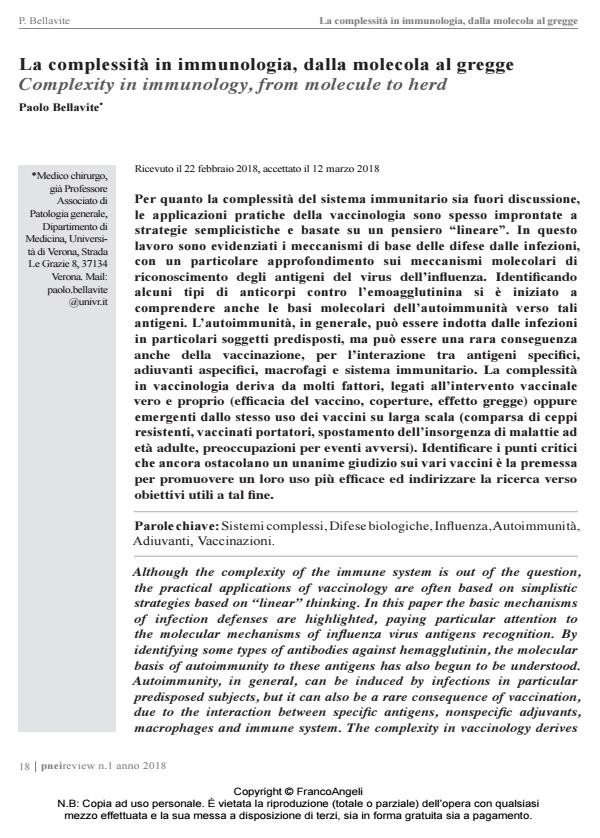La complessità in immunologia, dalla molecola al gregge
Titolo Rivista PNEI REVIEW
Autori/Curatori Paolo Bellavite
Anno di pubblicazione 2018 Fascicolo 2018/1
Lingua Italiano Numero pagine 23 P. 18-40 Dimensione file 1229 KB
DOI 10.3280/PNEI2018-001003
Il DOI è il codice a barre della proprietà intellettuale: per saperne di più
clicca qui
Qui sotto puoi vedere in anteprima la prima pagina di questo articolo.
Se questo articolo ti interessa, lo puoi acquistare (e scaricare in formato pdf) seguendo le facili indicazioni per acquistare il download credit. Acquista Download Credits per scaricare questo Articolo in formato PDF

FrancoAngeli è membro della Publishers International Linking Association, Inc (PILA)associazione indipendente e non profit per facilitare (attraverso i servizi tecnologici implementati da CrossRef.org) l’accesso degli studiosi ai contenuti digitali nelle pubblicazioni professionali e scientifiche
Per quanto la complessità del sistema immunitario sia fuori discussione, le applicazioni pratiche della vaccinologia sono spesso improntate a strategie semplicistiche e basate su un pensiero "lineare". In questo lavoro sono evidenziati i meccanismi di base delle difese dalle infezioni, con un particolare approfondimento sui meccanismi molecolari di riconoscimento degli antigeni del virus dell’influenza. Identificando alcuni tipi di anticorpi contro l’emoagglutinina si è iniziato a comprendere anche le basi molecolari dell’autoimmunità verso tali antigeni. L’autoimmunità, in generale, può essere indotta dalle infezioni in particolari soggetti predisposti, ma può essere una rara conseguenza anche della vaccinazione, per l’interazione tra antigeni specifici, adiuvanti aspecifici, macrofagi e sistema immunitario. La complessità in vaccinologia deriva da molti fattori, legati all’intervento vaccinale vero e proprio (efficacia del vaccino, coperture, effetto gregge) oppure emergenti dallo stesso uso dei vaccini su larga scala (comparsa di ceppi resistenti, vaccinati portatori, spostamento dell’insorgenza di malattie ad età adulte, preoccupazioni per eventi avversi). Identificare i punti critici che ancora ostacolano un unanime giudizio sui vari vaccini è la premessa per promuovere un loro uso più efficace ed indirizzare la ricerca verso obiettivi utili a tal fine.
Parole chiave:Sistemi complessi, Difese biologiche, Influenza, Autoimmunità, Adiuvanti, Vaccinazioni.
- Neuroprotective Potentials of Flavonoids: Experimental Studies and Mechanisms of Action Paolo Bellavite, in Antioxidants /2023 pp.280
DOI: 10.3390/antiox12020280
Paolo Bellavite, La complessità in immunologia, dalla molecola al gregge in "PNEI REVIEW" 1/2018, pp 18-40, DOI: 10.3280/PNEI2018-001003